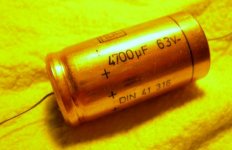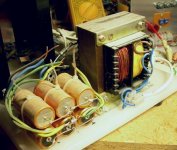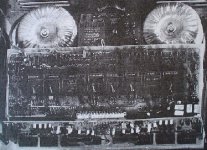Just curious, what are the benefits of dual power supplies for a two channel amp over using just one power supply with a toroid that supplies double the current?
How about one toroid feeding two power supplies?
Considering that the toroid is usually the most expensive part of an amp (depending on how much you spend on the chassis), it would be good to know what you were paying for.
How about one toroid feeding two power supplies?
Considering that the toroid is usually the most expensive part of an amp (depending on how much you spend on the chassis), it would be good to know what you were paying for.
This should explain some: http://www.stereophile.com/solidpoweramps/120147/index4.html
The Gaincard does have two PSUs, which is the way you should design a Gainclone regardless if you use one or two transformers. In the case of the Gaincard, it seems it doesn't have enough capacitance.
But the main reason for dedicated PSUs, I believe, is to reduce crosstalk.
The Gaincard does have two PSUs, which is the way you should design a Gainclone regardless if you use one or two transformers. In the case of the Gaincard, it seems it doesn't have enough capacitance.
But the main reason for dedicated PSUs, I believe, is to reduce crosstalk.
preiter said:Just curious, what are the benefits of dual power supplies for a two channel amp over using just one power supply with a toroid that supplies double the current?
How about one toroid feeding two power supplies?
Considering that the toroid is usually the most expensive part of an amp (depending on how much you spend on the chassis), it would be good to know what you were paying for.
I can see 2 reasons, why using dual mono with 2 trafos.
There may be several reasons for some to build this way.
But these resons are not very strong.
Most cases if you build and design in a good way
you will get just as good results using integrated stereo amplifier.
1. flexibility, you can use each unit on its on, using 2 boxes
2. minimum power supply interference between channels
if 2 power amps share same transformer
they are electrically connected to eachother
not only via ground 0 volt, but also via supply rails
a strong signal and current demand from channel 1
will effect power supply and maybe 'steal' away some power from channel 2
especially if power supply wasnt designed to avoid this
phn said:This should explain some: http://www.stereophile.com/solidpoweramps/120147/index4.html
The Gaincard does have two PSUs, which is the way you should design a Gainclone regardless if you use one or two transformers. In the case of the Gaincard, it seems it doesn't have enough capacitance.
That article called out the benefit of using the second Humpty power supply, but it didn't seem to be calling for separating the power sources of the two channel so much as just doubling the amount of power available overall.
I usually restrict myself
to use
1 transformer
2 rectifier bridges, using 4 normal slow silicon diodes in each bridge
these 2 rectifiers fead each a setup of electrolytic capacitors
of the size of 4700-10.000 uF
If some amplifier draws more current I just parallell a few more 4700-10.000 uF power supply capacitors.
There was a sale out of axial ROE ( Roderstein ) 4.700uF/63V caps.
So I bought 50 of those.
That box of good caps has supplied my projects last couple of years.
See attached picture.
So, the 2 amplifiers are fead from those rectifiers+filter caps.
Each amp channel having its own separate power supply.
Only share the transformer.
to use
1 transformer
2 rectifier bridges, using 4 normal slow silicon diodes in each bridge
these 2 rectifiers fead each a setup of electrolytic capacitors
of the size of 4700-10.000 uF
If some amplifier draws more current I just parallell a few more 4700-10.000 uF power supply capacitors.
There was a sale out of axial ROE ( Roderstein ) 4.700uF/63V caps.
So I bought 50 of those.
That box of good caps has supplied my projects last couple of years.
See attached picture.
So, the 2 amplifiers are fead from those rectifiers+filter caps.
Each amp channel having its own separate power supply.
Only share the transformer.
Attachments
here you can see how I
have created a current supply of parallelled caps
3+3 x 4700uF for +Volt and -Volt
The biggy old E-type transformer, probably a surplus buy,
I did adjust for my wanted voltage
by rewind secondary part of it.
Thick trafo wire ( 2 mm diameter, I think )
Fresh photo of the day,
with lots of dust on my gear, here:
on my gear, here:
have created a current supply of parallelled caps
3+3 x 4700uF for +Volt and -Volt
The biggy old E-type transformer, probably a surplus buy,
I did adjust for my wanted voltage
by rewind secondary part of it.
Thick trafo wire ( 2 mm diameter, I think )
Fresh photo of the day,
with lots of dust
 on my gear, here:
on my gear, here:Attachments
Hi,
One achieves most of the benefits of monoblocking and few of the downsides from the shared Vrails.
Next improvement is a four secondary transformer with one pair dedicated to the PSU on one channel and the other pair to the other channel. The problem with this option is the excessive cost of a new transformer to this specification. It is better if each secondary is rated not at 25% of full VA but at 30% to 50% of full VA. This makes it heavy and even more expensive.
I second this approach as excellent value for money.Each amp channel having its own separate power supply.
Only share the transformer.
One achieves most of the benefits of monoblocking and few of the downsides from the shared Vrails.
Next improvement is a four secondary transformer with one pair dedicated to the PSU on one channel and the other pair to the other channel. The problem with this option is the excessive cost of a new transformer to this specification. It is better if each secondary is rated not at 25% of full VA but at 30% to 50% of full VA. This makes it heavy and even more expensive.
AndrewT said:
Provide +-2mF to +-3mF/Apk of output current.
Simple, effective and reasonably economic.
Many builders and commentators support this view.
Yes, the rule of the thumb that I have learnt from audio magazines
and try to use is
2.000uF - 5.000uF for each 1 A max output
If going for 2mF or 5mF / 1A, depends a bit of type of amplifier and application.
Example.
Amplifier has a supply of +25V/-25V DC
Loudspeaker is 4 Ohms, nominal.
Peak current per channel will be < 25/4 ~6A
somthing like 6x2.000uF - 6x5.000uF = 12.000-30.000uF / channel
is what will give a good result.
I know Rod Elliott does not use too much, too big caps, in his Power Amplifiers
Here is a list of all his power amplifiers.
Some Chip Amps, too!
http://sound.westhost.com/projects-1.htm
phn said:mostly a gimmick
My goodness, someone has really been doing something wrong on this.
Attachments
jacco vermeulen said:
My goodness, someone has really been doing something wrong on this.
Not to mention the 175 pound Pass Labs XA 200 mono block. Of course mono blocks fill a purpose. Anyone knows that, I'm sure. But the 2x25W Gaincard is not such a case. Nor is dual mono phono stages. Like if there's no needle crosstalk!
- Status
- This old topic is closed. If you want to reopen this topic, contact a moderator using the "Report Post" button.
- Home
- Amplifiers
- Chip Amps
- Why dual mono?


